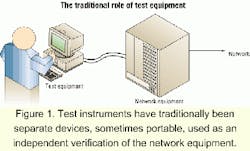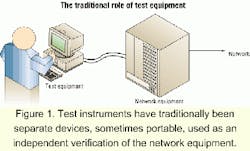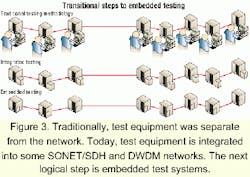DWDM embedded testing: the direction for the future in test and measurement
Multiple-wavelength systems present formidable challenges to established methodologies; full testing in the box offers a solution.
Doyle Mills, Digital Lightwave Inc.
Network equipment and test devices have generally remained distinct throughout the history of telecommunications. While modern network equipment does have some built-in diagnostics to detect alarm conditions and report these back to a central location, technicians still rely on test devices for every new equipment installation and to respond to any signs of network trouble.
Indeed, the test equipment market has flourished, despite some predictions in the early '90s. At that time, some people believed that SONET/SDH networks with sophisticated operations, administration, maintenance, and provisioning would displace most test devices. This did not come to pass.
A new technology that is challenging the established methodologies for testing and maintenance, which have served for so many years, is DWDM. DWDM is protocol-independent and does not readily provide any orderly system for performance monitoring or the reporting of errors or alarms. However, with full testing capabilities embedded in the DWDM equipment itself, troubleshooting could occur rapidly from a central location.
Network-equipment vendors generally do not make test equipment. And likewise, test-equipment manufacturers do not venture into network equipment to any large extent. This allows each type of company to concentrate attention, effort, and resources on what they do best. These vendors can also avoid conflicts of interest. Test-equipment manufacturers do not typically want to sell products that compete with their customers' offerings.Another factor in this separation is the perceived value in having independent confirmation of a network's integrity. If Acme Company came in and installed all the network equipment and tested it with Acme Company test equipment, it is perceived as somehow less certain, or less trustworthy, than using test equipment from another manufacturer. The concept of "perceived value in confirmation by a neutral party" could be the subject of entire article in and of itself.
Having separate test devices, which are physically carried around and connected to the network equipment as needed, is a simple, straightforward arrangement (see Figure 1). This method, at least on the surface, is also less expensive. But using separate test equipment does carry some liabilities.
Today, the traditional roles of network equipment and test equipment are strained, at best, to deal with the job at hand. Too many aspects of our lives today rely on telecommunications. With high-speed SONET/SDH and DWDM technology, the amount of valued information carried by a piece of equipment or one single transport medium is staggering. And if this equipment or medium is not functioning, the results can be devastating.
The old model of technicians driving around and connecting test equipment may be too slow and uncertain to serve at this time. There is precious time involved in physically locating, connecting, setting up, and operating the test device, often requiring hours of windshield time for the technician. Windshield time adds its own panoply of uncertainties such as city traffic, icy roads, and mechanical failures.
Hiring competent technicians and making sure all technicians on the network are trained in any and all types of test equipment that might be used is at best an administrative headache for network operators. In large networks, this means that hundreds of technicians must be trained and stationed throughout the network.
Test equipment must also always be available and functioning when needed. Portability of test equipment is both an advantage and a liability. Technicians may benefit from the ability to move the equipment where needed, but when a test device is required, it may also be in the wrong location. In some cases, portable test equipment gets "borrowed" at very inopportune times.
In the ideal world, network equipment and media would carry data flawlessly and never have trouble of any kind. That ideal, however, is certainly unattainable with any known or foreseeable technology.
As a slight step down from that, a network system could promptly report when it had a problem, and exactly what that problem was, to facilitate troubleshooting. All modern telecommunications equipment has some level of built-in monitoring. Minimally, this equipment can detect the presence or absence of a signal. Network protocols such as SONET/SDH and Gigabit Ethernet provide an orderly system for reporting errors and alarms.
DWDM, however, presents some challenges to self-monitoring technology that is currently available. DWDM is one of the technologies embraced on the fast-moving path to an all-optical network. Such a network, though nearly ideal in its ability to carry lots of data reliably and inexpensively, does not readily support the monitoring of protocols. Any form of protocol monitoring or analysis first requires a conversion from optical to electrical, which compromises the all-optical ideal.
Moreover, DWDM is protocol-independent. Therefore, any one fiber could carry a handful of different protocols, even proprietary protocols. And yet somehow network operators must be able to rapidly detect, troubleshoot, and fix problems on these systems.
At least for now, protocols such as SONET will continue to exist at the edges of DWDM. Thus, network operators will have good information available on whether the SONET signals experienced any errors while traversing the network (see Figure 2). But if the SONET protocol does identify that some problem exists, there is no information readily available on exactly what is happening with DWDM. Currently, the only solution is to dispatch a technician-or multiple technicians-to search for the problem on the network.With full testing capabilities embedded in the DWDM equipment itself available, troubleshooting could occur rapidly from a central location. Then if a technician is needed, he can be sent to the exact location, knowing in advance what the problem is.
Why is embedded testing needed in DWDM systems but not in older SONET/ SDH networks? SONET systems with only one wavelength are quite forgiving of some factors that are completely devastating to DWDM. One of these factors is dispersion, a "spreading out" of the signals, which should ideally be very sharp pulses of light. Other potential problems in multiple-wavelength systems are four-wave mixing, and when optical amplifiers are in use, amplified spontaneous emissions.
Dispersion characteristics have been known and measured for years, but a single-wavelength system was very tolerant of them. Two types of dispersion, chromatic dispersion and polarization-mode dispersion (PMD), were merely in the realm of the laboratory before DWDM. Now every field technician knows both types.
Chromatic dispersion comes about because different wavelengths travel through a medium at different rates. So light at one wavelength may arrive at the end of a fiber a little earlier than a different wavelength. This has two adverse effects on a DWDM system. First, a laser source, although considered to be one frequency, is actually a narrow band of frequencies; therefore, parts of each wavelength will arrive at the receive end earlier and later. This will result in a wider data pulse at the receive end. Higher bit rates mean smaller and smaller pulses and thus more likelihood that a wide pulse will interfere with adjacent pulse positions and cause transmission errors.
Chromatic dispersion is basically a characteristic of the particular fiber material and thus does not change through time or handling of a fiber. However, in real-world networks, occasionally it becomes necessary to change to a different fiber between nodes or between splice locations. This can mean switching to a fiber with different chromatic-dispersion characteristics, so technicians must be ready to deal with any changes.
PMD causes similar broadening of pulses but for a different reason. The core of an optical fiber is round, which allows light to travel down the fiber in multiple polarities. If fiber were indeed perfectly round throughout its entire length, then all polarization modes would travel at the same speed. However, in the real world, fiber is never exactly round throughout its length. Manufacturing defects, splices, macro-bends, micro-bends, temperature, pressure, or stretching of the fiber causes many instances of "non-roundness" along any fiber. The composite of all these irregularities amounts to the PMD of that fiber.
Therefore, PMD can change considerably throughout the service life of the fiber. Extreme caution should be taken with fiber splicing for DWDM. Network technicians should also avoid any unnecessary bending or stretching of the fiber.
While chromatic dispersion and PMD can happen on single-wavelength systems as well, in DWDM, dispersion is even more harmful. Dispersion is a nonlinearity, which causes signals to "mix" and create unwanted signals. One possible effect on multiwavelength systems is known as four-wave mixing. These unwanted additional signals cause crosstalk, which interferes with other wavelengths. Four-wave mixing is primarily the result of two factors: channel spacing and dispersion.
DWDM must be tested very thoroughly when first commissioned and may then need to be reevaluated as changes happen. Splicing, replacement of fibers, temperature differences, and the mishandling of fibers can cause great trouble to the network. Since PMD, chromatic dispersion, and four-wave mixing are wavelength-dependent, trouble may affect only one or two wavelengths while the rest function properly.
Maintaining such a network can be quite a feat with the antiquated method of separate test equipment. Having the test capability built into the equipment and controlled remotely at a central location is a promising solution.
While there may be a great desire or need for embedded testing capabilities, the prevailing methodologies will not go away overnight. The transition will take a bit of time, but when it does, networks will be much easier to commission and maintain.
One way to facilitate this transition is to integrate existing test equipment into the network. This was done for years in the DS-1/DS-0 world to keep up with the daunting number of circuits involved. Today, it is occurring in SONET/SDH and DWDM networks, but not many network operators have realized that the next logical step is to embed the testing capability into the network equipment itself (see Figure 3).Integrating testing systems into the network can be accomplished fairly rapidly. Test systems can be implemented at any number of locations as needed, which will provide network visibility where there was none. But this solution is not an end-all. There are many advantages to taking further steps to create a truly embedded solution.
One of the key benefits is that the testing plan and methodology can be thought out and included as part of the equipment from the beginning; the same vendor would supply both and network planning would be much easier. The test devices may, of course, be designed and manufactured by an outside source, such as with an original-equipment-manufacturer agreement. In this way the network equipment manufacturers can still concentrate on what they do best while providing a complete solution to customers.
Embedded test solutions will also make technician training a much simpler endeavor. Training is done on the equipment and the embedded test devices at the same time with a single vendor. Operating software issues are also greatly simplified, at least from the technician's point of view.
While older testing methodologies have served us well in many ways, we should never close our eyes to new solutions to problems, regardless of how radical the solutions may seem. Network operators can implement and maintain DWDM without a new look at how testing is done. But telecommunications-network operators must thrive in a cutthroat, competitive environment. If one provider cannot provide customers with near-perfect reliability and immediate solutions to network problems, another provider will.
In this business environment, some companies will prosper and profit, some will not. Some companies will survive and some will not. Choices such as testing methodologies can make the difference.
Doyle Mills is a senior technical-support engineer at Digital Lightwave (Clearwater, FL).



